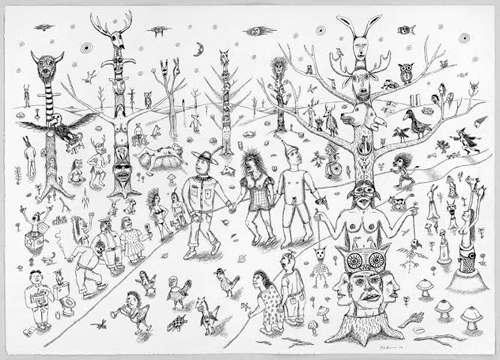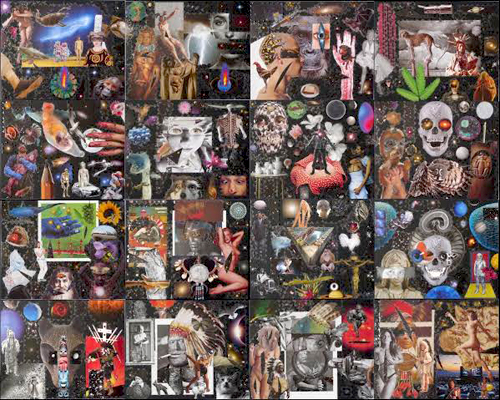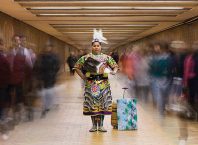 Since opening his first gallery in the
Since opening his first gallery in the
Minneapolis warehouse district’s Wyman Building in September 1984,
dealer Todd Bockley has carved out an idiosyncratic and activist
vision for art in the Twin Cities, one that is recognized not only by
the local cultural complex, but also far beyond. His unique and
personal purview on what art needs to see the light of day includes
that by a dozen Native American artists, both living and dead, whose
work finds consort with that of an equal number of other artists, a
broad-based cache of work that is largely defined by a distinctive
narrative stance or tinged with an untrained artist sensibility.
Consequently, Bockley Gallery’s
summer offering “Artists Singular: A Group Show” in his modest
storefront space on the west side of Lake of the Isles, is more
anticipated than unexpected. With eight works (really nine) by eight
artists, “Singular” follows the art world tradition of summer
shows being group shows that adhere to the Goldilocks principle —
not too big, not too small, but just right. As such, “Singular”
is a spirited mix of mostly untitled work both stylistically
figurative and abstract, by Bruce Anderson, Frank Big Bear, Jim
Denomie, George Morrison, Norval Morrisseau, Dietrich Sieling,
Elizabeth Simonson and John Snyder.
Sieling’s work just keeps getting
better in his provocative synthesis of figurative form and abstract
space. Working with marker on board, the artist has concocted an
oblique narrative that is rooted in a personal karaoke experience,
one that is riveting to observe. Multicolored abstract shapes,
suggesting a disco ball’s reflected patterns of light, hover above,
on and through mysterious figures in a spatially flat composition
that is remarkable in its complexity.
Jim Denomie’s untitled ink on paper
drawing is a departure from his typically color-laden work. Combining
Indian symbols and traditions with those of contemporary American
culture as he typically does, Denomie’s bawdy narrative references
the Wizard of Oz acted out by a rough-around-the-edges Kabala of
creatures and characters. Unexpectedly there is a visual clarity to
the work – which is not to suggest the narrative is easily
understood – in its straightforward graphic presentation, a quality
that not always defines his more vividly hued works.
Frank Big Bear’s “Black Collage”
is even more of a visual rout of the tensions between Indian and Pop
American cultures. Comprising a grid of 16 panels of  museum board
museum board
that have been collaged with all manner of images culled from
magazines and elsewhere, “Black Collage” is a visually exhausting
and, ultimately, unfocused work. Images of Indians, animals, planets,
religious icons, the night sky and totem poles, to identify only a
few out of dozens, mingle with passages of abstract form and color,
much of which is overlaid with triangular photo corners. While there
are arresting narrative passages and clever references to
contemporary art and culture, the preponderance of images of naked
women, largely of the pinup variety, becomes a tiresome refrain to an
otherwise potentially compelling song that ultimately deflates Black
Collage’s overall impact.
The late Anishinaabe artist, Norval
Morrisseau (1932-2007) is well represented by the painting “Flower
Arrangement.” Reflecting the Canadian artist’s signature style of
painting abstracted but representational forms in saturated colors
and outlined by thick black lines, the work depicts a potted spray of
flowers inhabited by birds and butterflies, that seemingly float
against an uninflected flat green ground. In its direct simplicity of
form and fearless color it is a fine example of the “Woodlands
School” or “Anishinaabe School” of Native art, which Morrisseau
founded.
John Snyder’s untitled sumi ink on
paper drawing is a gem and virtually dances in its pictographic
candor. Created in the limited palette of orange and black, a
quasi-figurative form moves through a field of symbols and abstract
forms in perfect compositional harmony.
Representing the stylistically abstract
camp are works by Bruce Anderson, George Morrison and Elizabeth
Simonson. Seeing Anderson’s 1986 untitled color pencil on paper
drawing was like bumping into an old friend. Widely exhibited at the
time of its making, it is a sophisticated amalgam of undisciplined
abstract form, Pollock-esque dribbles of black and silver enamel, all
illuminated by a screaming yellow ground. (The biggest surprise is
that this work is not part of someone’s collection after all these
years.) An untitled Abstract Expressionist painting from 1963
represents the late George Morrison (1919-2000). Its explosive
palette reminds us that Morrison was a true colorist. Much more
restrained are the two modestly scaled gouaches on paper drawings by
Elizabeth Simonson. Elegant in their monochromatic simplicity, the
works depict swirling circular forms, one red and one black, that
suggest subatomic particles in their movement and transparency.
“Artist Singular: A Group Show”
warrants a visit for anyone seeking a shot of art in the dog days of
summer.
Artist Singular: A Group Show
Through August 15, 2015
Bockley Gallery
2123 West 21st Street
Minneapolis, MN 55405
612-377-4669
information@bockleygallery.com
www.bockleygallery.com
PHOTOS: Jim Denomie, untitled, 2015, 32 x 40
inches, ink on paper (Courtesy photo.) (Top)
Frank Big Bear, Black Collage, 2015, 64 x 80 inches, collage on
museum board (Courtesy photo.) (Above)






